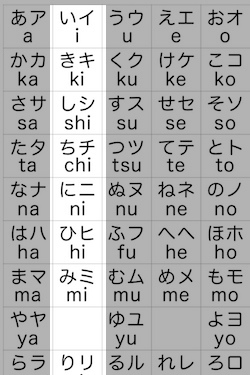❝ Benri Nihongo (BRNG.JP) is the only one providing Japanese Language Training for English Speakers in HK. ❞ ❝ I have no hesitation in highly recommending to you. ❞ Tsutomu Katayama, Director of Former Osaka Prefectural Government HK Office. ❝ Here you can enjoy learning Japanese as well as developing a sense of using Japanese. ❞ ❝ Benri Nihongo is the answer! ❞
Benri Nihongo
Complementary Japanese for Hkers & Eng Speakers in HK…
❝ Benri Nihongo (BRNG.JP) is the only one providing Japanese Language Training for English Speakers in HK. ❞ ❝ I have no hesitation in highly recommending to you. ❞ Tsutomu Katayama, Director of Former Osaka Prefectural Government HK Office. ❝ Here you can enjoy learning Japanese as well as developing a sense of using Japanese. ❞ ❝ Benri Nihongo is the answer! ❞
Japanese Euphony
Euphonic? Why?
Japanese verbs undergo some euphonic changes to link up “て” etc. Similarly when an adjective links up “ございます”, some euphonic changes will be needed. In the past papers of JLPT, such kind of questions have appeared several times. “ございます” is one of Japanese suffix to show “politeness” which is common in service industries. Nowadays some Japanese feel this kind of politeness is too grandiose (大袈裟) for daily usage, thus becoming less popular. Anyway, it is better to have a look in case you are sitting for the JLPT. #JLPT
Euphonic? How?
The appearance of a Japanese adjective is “***い”. We have to choose a suitable euphonic change for a particular adjective depending on the kana next to “い” (as shown below the 360° rotating kana with an arrow pointing to it).
If under ア, click here...

If the last kana next to い belongs to column ア,then make it change from column ア to column オ. And then remove い and add う. Finally put ございます next to it. That is grandiose form of Japanese adjecive. For example:
Example 1: 汚い
きたない (Dict Form)
↓
きたな (Dict Form w/o い)
↓
きたの (な becomes の)
↓
+ う + ございます
↓
きたのうございます (Grandiose Form)
Example 2: ありがたい
ありがたい (Dict Form)
↓
ありがた (Dict Form w/o い)
↓
ありがと (た becomes と)
↓
+ う + ございます
↓
ありがとうございます (Grandiose Form)
Quiz: How about the grandiose form of 早い and 目出度い? What could we get if we add prefix お ?
If under イ, click here...

If the last kana next to い belongs to column イ,then make it change from column イ to contracted sound of column ウ. And then remove い and add う. Finally put ございます next to it. That is grandiose form of Japanese adjecive. For example:
Example 1: 大きい
おおきい (Dict Form)
↓
おおき (Dict Form w/o い)
↓
おおきゅ (き becomes きゅ)
↓
+ う + ございます
↓
おおきゅうございます (Grandiose Form))
Example 2: 美味しい
おいしい (Dict Form)
↓
おいし (Dict Form w/o い)
↓
おいしゅ (し becomes しゅ)
↓
+ う + ございます
↓
おいしゅうございます (Grandiose Form)
The rest, click here...
If the last kana next to い belongs to neither column ア nor column イ,you just simply remove the last い and add う. Finally put ございます next to it. That is grandiose form of Japanese adjecive. For example:
Example 1: 寒い
さむい (Dict Form)
↓
さむ (Dict Form w/o い)
↓
さむ + う + ございます
↓
さむうございます (Grandiose Form)
Example 2: 広い
ひろい (Dict Form)
↓
ひろ (Dict Form w/o い)
↓
ひろ + う + ございます
↓
ひろうございます (Grandiose Form)
Reference:
- Dr Hsieh, Yih-Lang (謝逸朗教授) - 明解日本口語語法用言篇(文笙書局)
- The NHK Broadcasting Culture Research Institute(NHK放送文化研究所) - 最近気になる放送用語
Choose the best answer, A, B, C or D, to the question below.
A お高う
B お高い
C 高いに
D 高いで
(Selected from JLPT Lv 3 {N4 Equivalent} in yr 2000)
Click here for the answer:
According to the rules mentioned above, the answer is: A



